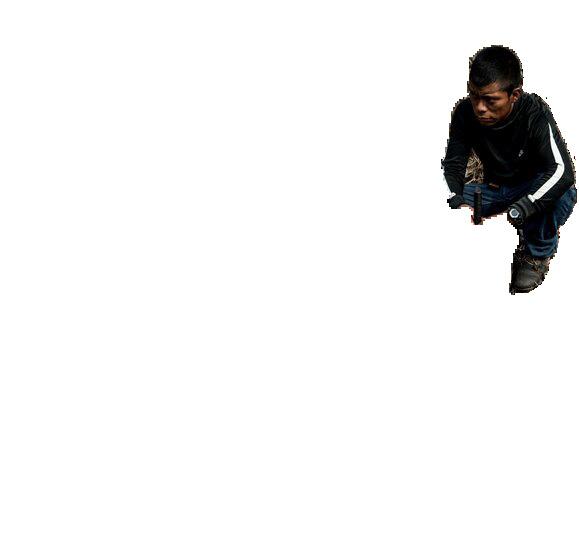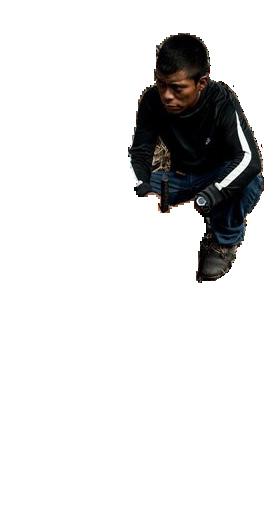
14 minute read
JUSTIFICATION SETTINGS
from Publication Design
by Julia Kline
In the late 1960s, a television producer named Joan Gantz Cooney set out to start an epidemic. Her target was three-, four-, and five-year-olds. Her agent of infection was television, and the “virus” she wanted to spread was literacy. The show would last an hour and run five days a week, and the hope was that if that hour was contagious enough it could serve as an educational Tipping Point: giving children from disadvantaged homes a leg up once they began elementary school, spreading prolearning values from watchers to nonwatchcrs, infecting children and their parents, and lingering long enough to have an impact well alter the children stopped watching the show. By any measure, this was an audacious idea. Television is a great way to reach lots of people, very easily and cheaply. It entertains and dazzles. Bui it isn’t a particularly educational medium. Gerald Lesser, a Harvard University psychologist who joined with Cooney in founding Sesame Street, says that when he was first asked to join the project, back in the late 1960s, he was skeptical. “I had always been very much into fitting how you teach to what you know about the child,” he says. “You try to find the kid’s strengths, so you can play to them. You try to understand the kid’s weaknesses, so you can avoid them. Then you try and teach that individual kid’s profile.... Television has no potential, no power to do that.” Good teaching is interactive. It engages the child individually. It uses all the senses. It responds to the child. But a television is just a talking box.
But Cooney and Lesser and a third partner—
Advertisement
Lloyd Morrisett of the Markle Foundation in New York — set out to try anyway. They enlisted some of the top In the late 1960s, a television producer named Joan Gantz Cooney set out to start an epidemic. Her target was three-, four-, and five-year-olds. Her agent of infection was television, and the “virus” she wanted to spread was literacy. The show would last an hour and run five days a week, and the hope was that if that hour was contagious enough it could serve as an educational Tipping Point: giving children from disadvantaged homes a leg up once they began elementary school, spreading prolearning values from watchers to nonwatchcrs, infecting children and their parents, and lingering long enough to have an impact well alter the children stopped watching the show. * By any measure, this was an audacious idea. Television is a great way to reach lots of people, very easily and cheaply. It entertains and dazzles. Bui it isn’t a particularly educational medium. Gerald Lesser, a Harvard University psychologist who joined with Cooney in founding Sesame Street, says that when he was first asked to join the project, back in the late 1960s, he was skeptical. “I had always been very much into fitting how you teach to what you know about the child,” he says. “You try to find the kid’s strengths, so you can play to them. You try to understand the kid’s weaknesses, so you can avoid them. Then you try and teach that individual kid’s profile.... Television has no potential, no power to do that.” Good teaching is interactive. It engages the child individually. It uses all the senses. It responds to the child. But a television is just a talking box. * But Cooney and Lesser and a third partner— Lloyd Morrisett of the Markle Foundation in New York — set out to try anyway. They enlisted some of the top creative minds of the period. They borrowed techniques from television commercials to teach children about numbers. They used the live animation of Saturday morning cartoons to teach lessons about learning the alphabet. They brought in celebrities to sing and dance and star in comedy sketches that taught children about the virtues of cooperation or about their own emotions. Sesame Street aimed higher and tried harder than any other children’s show had, and the extraordinary thing was that it worked. Virtually every time the show’s educational value has been tested — and Sesame Street has been subject to more academic scrutiny than any television show in history — it has been proved to increase the reading and learning skills of its viewers.
word spacing: 80% 85% 87% letterspacing 0% 0% 20%
In the late 1960s, a television producer named Joan Gantz Cooney set out to start an epidemic. Her target was three-, four-, and five-year-olds. Her agent of infection was television, and the “virus” she wanted to spread was literacy. The show would last an hour and run five days a week, and the hope was that if that hour was contagious enough it could serve as an educational Tipping Point: giving children from disadvantaged homes a leg up once they began elementary school, spreading prolearning values from watchers to nonwatchcrs, infecting children and their parents, and lingering long enough to have an impact well alter the children stopped watching the show. By any measure, this was an audacious idea. Television is a great way to reach lots of people, very easily and cheaply. It entertains and dazzles. Bui it isn’t a particularly educational medium. Gerald Lesser, a Harvard University psychologist who joined with Cooney in founding Sesame Street, says that when he was first asked to join the project, back in the late 1960s, he was skeptical. “I had always been very much into fitting how you teach to what you know about the child,” he says. “You try to find the kid’s strengths, so you can play to them. You try to understand the kid’s weaknesses, so you can avoid them. Then you try and teach that individual kid’s profile.... Television has no potential, no power to do that.” Good teaching is interactive. It engages the child individually. It uses all the senses. It responds to the child. But a television is just a talking box.
But Cooney and Lesser and a third partner—
Lloyd Morrisett of the Markle Foundation in New York — set out to try anyway. They enlisted some of the top In the late 1960s, a television producer named Joan Gantz Cooney set out to start an epidemic. Her target was three-, four-, and five-year-olds. Her agent of infection was television, and the “virus” she wanted to spread was literacy. The show would last an hour and run five days a week, and the hope was that if that hour was contagious enough it could serve as an educational Tipping Point: giving children from disadvantaged homes a leg up once they began elementary school, spreading prolearning values from watchers to nonwatchcrs, infecting children and their parents, and lingering long enough to have an impact well alter the children stopped watching the show. * By any measure, this was an audacious idea. Television is a great way to reach lots of people, very easily and cheaply. It entertains and dazzles. Bui it isn’t a particularly educational medium. Gerald Lesser, a Harvard University psychologist who joined with Cooney in founding Sesame Street, says that when he was first asked to join the project, back in the late 1960s, he was skeptical. “I had always been very much into fitting how you teach to what you know about the child,” he says. “You try to find the kid’s strengths, so you can play to them. You try to understand the kid’s weaknesses, so you can avoid them. Then you try and teach that individual kid’s profile.... Television has no potential, no power to do that.” Good teaching is interactive. It engages the child individually. It uses all the senses. It responds to the child. But a television is just a talking box. * But Cooney and Lesser and a third partner— Lloyd Morrisett of the Markle Foundation in New York — set out to try anyway. They enlisted some of the top creative minds of the period. They borrowed techniques from television commercials to teach children about numbers. They used the live animation of Saturday morning cartoons to teach lessons about learning the alphabet. They brought in celebrities to sing and dance and star in comedy sketches that taught children about the virtues of cooperation or about their own emotions. Sesame Street aimed higher and tried harder than any other children’s show had, and the extraordinary thing was that it worked. Virtually every time the show’s educational value has been tested — and Sesame Street has been subject to more academic scrutiny than any television show in history — it has been proved to increase the reading and learning skills of its viewers.
word spacing: 80% 82% 84% letterspacing 0% 0% 40%
In the late 1960s, a television producer named Joan
Gantz Cooney set out to start an epidemic. Her target was three-, four-, and five-year-olds. Her agent of infection was television, and the “virus” she wanted to spread was literacy. The show would last an hour and run five days a week, and the hope was that if that hour was contagious enough it could serve as an educational Tipping Point: giving children from disadvantaged homes a leg up once they began elementary school, spreading prolearning values from watchers to nonwatchcrs, infecting children and their parents, and lingering long enough to have an impact well alter the children stopped watching the show. By any measure, this was an audacious idea. Television is a great way to reach lots of people, very easily and cheaply. It entertains and dazzles. Bui it isn’t a particularly educational medium. Gerald
Lesser, a Harvard University psychologist who joined with Cooney in founding Sesame Street, says that when he was first asked to join the project, back in the late 1960s, he was skeptical. “I had always been very much into fitting how you teach to what you know about the child,” he says. “You try to find the kid’s strengths, so you can play to them. You try to understand the kid’s weaknesses, so you can avoid them. Then you try and teach that individual kid’s profile.... Television has no potential, no power to do that.” Good teaching is interactive. It engages the child individually. It uses all the senses. It responds to the child. But a television is just a talking box. But Cooney and Lesser and a third partner—
Lloyd Morrisett of the Markle Foundation in New York — set out to try anyway. They enlisted some of the top In the late 1960s, a television producer named Joan Gantz Cooney set out to start an epidemic. Her target was three-, four-, and five-year-olds. Her agent of infection was television, and the “virus” she wanted to spread was literacy. The show would last an hour and run five days a week, and the hope was that if that hour was contagious enough it could serve as an educational Tipping Point: giving children from disadvantaged homes a leg up once they began elementary school, spreading prolearning values from watchers to nonwatchcrs, infecting children and their parents, and lingering long enough to have an impact well alter the children stopped watching the show. * By any measure, this was an audacious idea. Television is a great way to reach lots of people, very easily and cheaply. It entertains and dazzles. Bui it isn’t a particularly educational medium. Gerald Lesser, a Harvard University psychologist who joined with Cooney in founding Sesame Street, says that when he was first asked to join the project, back in the late 1960s, he was skeptical. “I had always been very much into fitting how you teach to what you know about the child,” he says. “You try to find the kid’s strengths, so you can play to them. You try to understand the kid’s weaknesses, so you can avoid them. Then you try and teach that individual kid’s profile.... Television has no potential, no power to do that.” Good teaching is interactive. It engages the child individually. It uses all the senses. It responds to the child. But a television is just a talking box. * But Cooney and Lesser and a third partner— Lloyd Morrisett of the Markle Foundation in New York — set out to try anyway. They enlisted some of the top creative minds of the period. They borrowed techniques from television commercials to teach children about numbers. They used the live animation of Saturday morning cartoons to teach lessons about learning the alphabet. They brought in celebrities to sing and dance and star in comedy sketches that taught children about the virtues of cooperation or about their own emotions. Sesame Street aimed higher and tried harder than any other children’s show had, and the extraordinary thing was that it worked. Virtually every time the show’s educational value has been tested — and Sesame Street has been subject to more academic scrutiny than any television show in history — it has been proved to increase the reading and learning skills of its viewers.
In the late 1960s, a television producer named Joan Gantz Cooney set out to start an epidemic. Her target was three-, four-, and five-year-olds. Her agent of infection was television, and the “virus” she wanted to spread was literacy. The show would last an hour and run five days a week, and the hope was that if that hour was contagious enough it could serve as an educational Tipping Point: giving children from disadvantaged homes a leg up once they began elementary school, spreading prolearning values from watchers to nonwatchcrs, infecting children and their parents, and lingering long enough to have an impact well alter the children stopped watching the show. By any measure, this was an audacious idea. Television is a great way to reach lots of people, very easily and cheaply. It entertains and dazzles. Bui it isn’t a particularly educational medium. Gerald Lesser, a Harvard University psychologist who joined with Cooney in founding Sesame Street, says that when he was first asked to join the project, back in the late 1960s, he was skeptical. “I had always been very much into fitting how you teach to what you know about the child,” he says. “You try to find the kid’s strengths, so you can play to them. You try to understand the kid’s weaknesses, so you can avoid them. Then you try and teach that individual kid’s profile.... Television has no potential, no power to do that.” Good teaching is interactive. It engages the child individually. It uses all the senses. It responds to the child. But a television is just a talking box. But Cooney and Lesser and a third partner— Lloyd Morrisett of the Markle Foundation in In the late 1960s, a television producer named Joan Gantz Cooney set out to start an epidemic. Her target was three-, four-, and five-year-olds. Her agent of infection was television, and the “virus” she wanted to spread was literacy. The show would last an hour and run five days a week, and the hope was that if that hour was contagious enough it could serve as an educational Tipping Point: giving children from disadvantaged homes a leg up once they began elementary school, spreading prolearning values from watchers to nonwatchcrs, infecting children and their parents, and lingering long enough to have an impact well alter the children stopped watching the show. * By any measure, this was an audacious idea. Television is a great way to reach lots of people, very easily and cheaply. It entertains and dazzles. Bui it isn’t a particularly educational medium. Gerald Lesser, a Harvard University psychologist who joined with Cooney in founding Sesame Street, says that when he was first asked to join the project, back in the late 1960s, he was skeptical. “I had always been very much into fitting how you teach to what you know about the child,” he says. “You try to find the kid’s strengths, so you can play to them. You try to understand the kid’s weaknesses, so you can avoid them. Then you try and teach that individual kid’s profile.... Television has no potential, no power to do that.” Good teaching is interactive. It engages the child individually. It uses all the senses. It responds to the child. But a television is just a talking box. * But Cooney and Lesser and a third partner— Lloyd Morrisett of the Markle Foundation in New York — set out to try anyway. They enlisted some of the top creative minds of the period. They borrowed techniques from television commercials to teach children about numbers. They used the live animation of Saturday morning cartoons to teach lessons about learning the alphabet. They brought in celebrities to sing and dance and star in comedy sketches that taught children about the virtues of cooperation or about their own emotions. Sesame Street aimed higher and tried harder than any other children’s show had, and the extraordinary thing was that it worked. Virtually every time the show’s educational value has been tested — and Sesame Street has been subject to more academic scrutiny than any television show in history — it has been proved to increase the reading and learning skills of its viewers.





